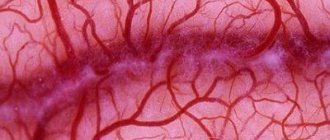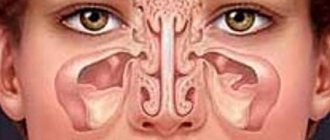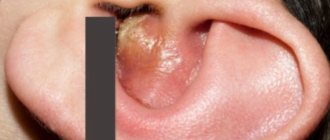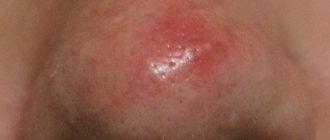Any medicine has both positive and negative properties. Of course, the former appear much more often and on a larger scale than the latter. However, improper use of the medication often provokes its harmful effects on the body. A striking example of such a phenomenon can be the abuse of Naphthyzin.
These drops, like many vasoconstrictors, can be highly addictive, adversely affecting the vessels of the nasal mucosa. Sometimes it comes to the point that a cold is cured in a week, and a runny nose has been eliminated with “harmless drops” for the second year already. The difficulty of getting rid of such an addiction is pronounced and quite justified, but is it really so serious? Let's figure out how to get rid of dependence on Naphthyzin and prevent it in the future.
Causes of naphthyzine addiction
Improper use of Naphthyzin can cause addiction
Naphthyzin is a drug intended for instillation into the nose. The main active ingredient of this medication is naphazoline, which helps to significantly relieve nasal congestion of any etiology, but on a short-term basis. The principle of action of the drops is based on the narrowing of the blood vessels of the nasal mucosa, which, in turn, reduces swelling and temporarily neutralizes the secretion of mucus.
Taking Naphthyzin is an extremely convenient measure in the process of treating colds or allergic rhinitis. Not only is the drug very cheap, but its effect is colossal. Despite this, most people who start taking Naphthyzin cannot stop, as a result of which they develop dependence on the drug.
The nature of such addiction is very simple. The essence of dependence on Naphthyzin is that a temporary narrowing of blood vessels, after the end of the drug’s effect, leads to their greater expansion. As a result, several phenomena occur at once:
- firstly, the amount of mucus secreted increases
- secondly, it becomes impossible to get rid of a runny nose using simple methods
- thirdly, a person has only one choice - to instill Naphthyzin
With time of getting used to the drug, its effect becomes even less short-term and the dosage increases exorbitantly. In the end, a person’s life without Naphthyzin looks impossible, since without instilling these drops, nasal congestion becomes unbearable and causes serious discomfort.
Drug-assisted habit-breaking
We get rid of addiction gradually by reducing the dosage
As is now clear, dependence on Naphthyzin occurs due to spasm of the vessels of the nasal mucosa, which is abnormal for human physiology. As a result of this phenomenon, it is no longer pathological nasal congestion that develops, but a real drug-induced runny nose.
You can get rid of it, but only with a competent approach to the matter. In most cases, naphthyzine addiction can be overcome through drug withdrawal from the habit.
The essence of such therapy is as follows:
- Completely replace Naphthyzin with drops that are less potent in affecting blood vessels or other methods of treating a runny nose (for example, homeopathy). You can find out about the effect of certain drops from the pharmacist at the pharmacy. The most effective and at the same time harmless to the body way of getting rid of naphthyzine addiction is the use of drops based on sea water and salts.
- Organize systematic rinsing of the nose with special solutions purchased at the pharmacy. Furacilin or Boric acid can be used as similar ones.
- Start doing breathing exercises. Its essence is to complement the action of the medications presented above and “relearn” how to breathe without Naphthyzin. It is enough to carry out the procedure for 10-15 minutes daily.
An alternative way to get rid of naphthyzine addiction with medication is to dilute the culprit of the addiction with some water before use.
If self-medication of addiction causes any difficulties, it is advisable to seek help from a professional doctor.
For example, the first week of treatment you use a solution of drops and water in the proportion “1:1”, the next week – “1:2”, the next couple of weeks – “1:3”, and then you completely abandon Naphthyzin and go, for example, to harmless Pinosol.
Surgical treatment of addiction
The method of surgery is determined based on the severity of the addiction
In especially severe cases, when dependence on Naphthyzin is long-term, drug therapy may not produce results. In such situations, surgical intervention will help to completely overcome the habit.
The general essence of this method of therapy is that the surgeon partially disrupts the vascular structure of the mucosa, which leads to the growth of new vessels that are already independent of Naphthyzin.
Depending on the individual characteristics of each case, you may need:
- laser, ultrasound or shaver destruction
- cryodestruction
- submucosal vasotomy
- coblation
Any type of surgical operation takes no more than half an hour and is performed under local anesthesia. After the procedure, wounds in the nose are treated for a week with special antibacterial agents prescribed by the doctor. Having carried out such therapy, it is impossible to use any vasoconstrictor drops again, because it will be extremely difficult to cure their dependence again.
Traditional medicine against addiction
Nasal rinsing will help you quickly get rid of naphthyzine addiction
Traditional methods of getting rid of naphthyzine addiction also have their place. However, it is worth understanding that traditional medicine will be effective only if there is a short-term and mild dependence on Naphthyzin. In other cases, it is better to use the previously presented methods of getting rid of the habit.
Returning to traditional medicine, we will highlight the following remedies that can help eliminate naphthyzine addiction:
- Garlic aromatherapy. The essence of this method is that after giving up Naphthyzin, the patient stimulates his mucous membranes by inhaling garlic vapor. To begin with, it is advisable to cut one clove of garlic and insert each half into your nose, trying to breathe for a few seconds. After some effect appears, garlic steam can be inhaled without inserting it into the nose. It is advisable to repeat the procedure twice a day.
- Treatment with celandine juice. This method, in turn, is an excellent alternative to using medicinal drops. To obtain the effect, it is enough to replace Naphthyzin with drops of celandine juice. The product is instilled in its pure form, one drop into each nostril 2-3 times a day.
- Decoctions for washing. This remedy can complement the effect of the previously presented methods of folk recovery from naphthyzine addiction. To prepare it, you can make a decoction of any medicinal herb by pouring a glass of boiling water over the last tablespoon. The resulting broth should be left for a couple of hours and strained, and then used for rinsing. The procedure should be repeated twice a day.
In general, traditional methods are a common alternative to medications. Despite this, it is less effective, which should be taken into account when organizing getting rid of naphthyzine addiction in a similar way.
What is naphthyzine addiction?
Let’s say right away that you should be wary of not only Naphthyzin (naphazoline) - pathology can occur with the uncontrolled use of any drops or sprays with a vasoconstrictor effect. That is, xylometazoline (Otrivin, Galazolin, Xymelin), and oxymetazoline (Nazol), and other similar drugs can cause addiction.
The mechanism of development of the pathological condition is as follows:
- When swelling of the nasal mucosa caused by rhinitis, a person constantly uses vasoconstrictor drugs - breathing becomes easier;
- The vessels of the mucous membrane are constantly in a spasmodic state (due to drops) and lose the ability to function normally - “reactive” edema occurs. That is, the nose is stuffy not because of the inflammatory process, but because the capillaries react this way to the end of the medicine;
- New swelling forces the patient to continue the “treatment”. In other words, it increases the load on the vessels, increasingly affecting their health;
- A condition called “medicinal vasomotor rhinitis” develops. The tone of the capillaries in the nasal mucosa is impaired - they cannot narrow on their own. The tissues are swollen, breathing is difficult, and mucus hypersecretion occurs.
It is clear that admitting to others that you have such a problem is a shame. See a doctor too. It’s not possible to “endure it” on your own and not take drops, because the lack of nasal breathing is extremely painful. Constant nasal congestion causes headaches and insomnia. Because of the “hundiness” it turns out to be more difficult to communicate with people. In addition, the addict is afraid that his loved ones will notice his addiction...
So psychological problems are added to physical problems. The person tries to mask the problem, hopes that everything will go away on its own and continues to drip Naphthyzin (or another remedy). And this lasts for years or even decades! You can meet “confession” people on the Internet with experience of naphthyzine addiction for up to 20 years or more!
The outcome of this condition is atrophy of the nasal mucosa. It stops performing its functions and dries out. And although the swelling disappears at this time, this pathology is much more severe than the previous one. The patient experiences constant dry mouth and irritation in the nose. He is susceptible to all airborne infections. Inflammation and purulent processes occur on the walls of the nostrils, and they become covered with dry crusts. Next, tissue breakdown occurs, which affects surrounding organs.
How to prevent dependence on Naphthyzin
Naphthyzin must be used strictly according to the instructions!
Having understood the essence of dependence on Naphthyzin and the methods of getting rid of it, it would not be amiss to consider how to prevent the development of such a habit.
In fact, the essence of such an event is extremely simple and consists in implementing the following procedures:
- The main thing is not to use Naphthyzin after complete recovery from the illness that caused the runny nose. Even if there is congestion, it is advisable to endure it for a couple of days, after which it is guaranteed that it will become easier to breathe.
- While taking Naphthyzin, be sure to lead a normal lifestyle: good sleep, proper nutrition, and so on.
- Do not use drops under any circumstances if there are contraindications to their use. This not only provokes addiction, but also increases the risk of developing serious complications.
- During treatment with Naphthyzin, also do not forget to carry out systematic steam inhalations, which will help your blood vessels to tolerate the effect of the drug normally.
More information on how to get rid of naphthyzine addiction can be found in the video:
Complex nasal drops for children: composition, purpose and use
Following the recommendations presented above, the development of naphthyzine addiction is unlikely to complicate your life. When getting rid of a runny nose with Naphthyzin, remember that this drug does not cure the disease, it only eliminates temporary symptoms. As a result, it is often not worth dripping drops, since it is not only useless, but also harmful to the vessels of the nasal mucosa.
In general, getting rid of naphthyzine addiction is not so problematic even if it has been present for a long time. In any case, it is easier to prevent such a habit from occurring. We hope the material presented above was useful to you. Good luck with your treatment and good health to you!
How to get rid of naphthyzine addiction: personal experience
Over the past twelve or so years, from time to time I have been worried about the question of how to get rid of naphthyzine addiction . The addiction itself was constant, but I rarely thought about the need to give up naphthyzine. I just made sure that there was always a bottle, or even two, of “breathing” liquid in my purse. It was very inconvenient, but over time I got used to it. The worst thing was to forget a bottle of naphthyzine at home, and there was no pharmacy near work. Then I started to panic, frantically asked the employees if they happened to have nasal drops, asked those employees who were still on the way to buy drops... And once even an unfamiliar courier... But most often I was never able to find naphthyzin and I I had to leave work early.
What happened to me already half an hour after I discovered the absence of drops! My nose was swollen and seemed larger than my face, my head ached in my temples, my eyes were burning, my mouth and throat were dry, I couldn’t speak or pronounce words, it was impossible to read, and of course, to write too...
How to cure addiction to naphthyzine ? It seemed to me that there was no way, that it was impossible. I tried a bunch of drugs, almost got hooked on even stronger ones, rinsed with salt and sea water, dripped with boiled brine…. It was all in vain.
Mom and dad advised me to wait a week or two. But I couldn’t stand it for 15 minutes! Those who have not yet gotten rid of naphthyzine addiction will understand me.
Then I asked the all-knowing Google for help, entered something like “ how to get rid of addiction to naphthyzin ” into the search bar (not my wording, Google suggested). And I ended up on a forum, I don’t even remember which site. I made two discoveries from the forum: there are a lot of people suffering from naphthyzine addiction, and I’m not the only one. The second discovery is that people’s imagination knows no bounds.
What the forum members didn’t do to cure their addiction to naphthyzin ! An ordinary person would never dream of this even in a nightmare. Here is just a small part of the advice from people who tried to give up naphthyzin and reported on their progress on the forum: *one man stood on his head and spent some time in this position. At the same time, he complained about a strange liquid that was almost flooding his brains, his eyes were bulging and, naturally, his face was turning red, out of habit, because all the blood was rushing to his head * the unfortunate girl begged for help online, saying she hadn’t had any dripping for two days, tie me to the computer, talk to me, otherwise, they say, her legs are already halfway to the pharmacy *an enterprising guy mixed all kinds of drugs into one, obviously without a pharmaceutical education, and also advised others, although he still hasn’t gotten rid of it himself
There were also tips that did not help at all, perhaps accidentally curing addiction to naphthyzine : instilling sea water, rinsing with hydrogen peroxide, all kinds of advertising for other vasoconstrictor drugs, instilling salt water... All these remedies certainly have the right to life. BUT... combined with inhuman patience. That is, it was the same as just waiting it out, but still bothering with ineffective lotions.
I had a lot of fun on that forum. But there was only one useful thing: the advice to drip into only one nostril for a while. The second during this period should revive the natural human ability to breathe independently. I don’t know how long I’ll have to do this. It's different for everyone. Let me just say that this is also not easy - half of the face still becomes full and swollen. But if you take any allergy medication at the same time, it will be much easier. But not completely, I won’t lie.
Honestly, I couldn’t get rid of naphthyzine addiction this way. I was overcome by headaches - and I chose to become dependent on naphthyzine...
Of course, all this time I understood that the reason was not just naphthyzin - the body, for certain reasons, was blocking my ability to breathe. The ability to breathe is given to us by nature free of charge, like all other vital processes in the body. Since the ability to breathe is blocked, it means that somewhere deep in my head there was an unwillingness to live, aggression towards life, and perhaps a deep, unprocessed feeling of guilt blocked my ability to breathe in air without effort... There could be many reasons. And finding this cause and eliminating it myself turned out to be unrealistic for me too. I was completely confused and even panicked a little. But not for long - with a calm soul I continued to drip, and drip, and drip... for more than ten years.
But there is good news: now I have not been dripping my nose for almost a month. I got rid of the need to drip my nose several times a day easily, without making any effort, naturally, as if I had not been addicted to naphthysine for the last decade.
I spent a long time analyzing how I managed to get rid of my addiction to naphthyzine . I wanted to show other addicted drippers an easy path to healing. I will give below my actions that preceded how I began to breathe freely without droplets.
I will give below my actions that preceded how I began to breathe freely without droplets.
Comments (1)
Sergey
01/08/2019 at 17:35 |
I used naphthyzin for more than seven years, but in December naphthyzin stopped helping me at all, and I decided to stop taking it, I went online and read articles. The first three days without naphthyzin were terrible, the pressure was 110 to 190, I called an ambulance, I slept literally three hours a day .But I instilled my nose with AQUA MORICE spray for three days and I used naphthyzinnosol, the first aqua rinses the nose and the second pinosol treats the first two days I instilled 5-6 times, on the third day I began to instill less pinosol and aqua, on the sixth day I I instilled them only once at night. Two weeks have passed since I haven’t used anything. But the most important thing is not to drip naphthyzin for the first few days, maybe my advice will help someoneAnswer
How to get rid of naphthyzine addiction
After reading the post https://pikabu.ru/story/borba_s_zavisimostyu_5550330 I remembered my insurmountable dependence on vasoconstrictors and how to get rid of it. I just got hooked on the drops; I caught a runny nose on the street and started taking drops from time to time. But then I suddenly thought that it was time to stop, but my nose was completely clogged and I couldn’t sleep in that state. That’s how I became a naphthyzine “addict.” Now closer to the point) The recipe itself: 1) Buy a new bottle of naphthyzine 2) Continue to drip it with the same frequency as before 3) After about 15% of the drops in the bottle have disappeared, add clean water to it ( I took the usual one from the tap) 4) We continue to gradually dilute naphthyzin, reducing its concentration. Over time, it will become easier to breathe and you yourself will understand when it will be possible to sleep without “naphthyzin withdrawal.” If it helps anyone, then the post was not written in vain) Don’t kick too hard and Happy New Year)











